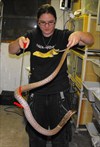|
Q:
|
Freezing Reptiles as Euthanasia
|
|
this was asked of one of our network vets, Dr Maas, a few years ago. this is the question that came in, as well as what he wrote for our newsletter (this is why you should all join pnhs; the NLs are great!):
Dear Doctor Maas,
My snake has been sick with a respiratory infection for several years. I have taken him to a couple of vets, who look at him and each time put him on several different antibiotics. A couple times he has gotten better for a brief period of time but then the infection returns. At this point, he has lost a lot of weight from not eating and moves about very little. I think he is suffering, and think he should be put down. I was told that I could put him in the refrigerator or freezer and chill him down to the point that he dies. This sounds awful, but was told this was the best way to put him to sleep. What do you think?
- Not Ready to Ice Him.
Dear Ice,
You are very correct: Chilling a herp to death is an awful way to die, and, could they speak, they would describe it as torture. The American Veterinary Medical Association and the American Association of Zoological Veterinarians classify this as cruel treatment of animals and animal abuse and the Association of Reptile and Amphibian Veterinarians categorize it as an unacceptable method of euthanasia, as well. If a veterinarian recommended this to you, it could be categorized as malpractice.
Unfortunately, the myth that freezing herps is a good way to put them down persists. It almost makes sense, being that reptiles and amphibians are “cold-blooded”, but in fact, this adaptation makes this procedure even worse for them. This is because as they get cold, they become torporous, that is, alert mentally but unable to move or respond. This is in contrast to mammals, which become unable to move, but also become mentally dull and comatose as they become hypothermic. As a result, reptiles and amphibians can feel their body get cold, which produces pain, but they can do nothing about it. Studies show that they can, literally, feel their cells freeze and rupture as they get further chilled, sensing pain as intensely as if they were being burned alive, but unable to move or respond.
What defines an acceptable method of euthanasia? Simply put, it must be a method that provides a safe, painless form of death. Additionally, it should be quick and effective, not allowing the animal to suffer either mentally or physically. The most common and accepted form is a single intravenous injection of sodium pentobarbital, an anesthetic drug that when given at an overdose amount, stops the brain, heart and lungs. Alternative methods include rapid decapitation (this must take less than 1/10 of a second to be painless, such as with a cleaver or sharp axe), pithing, or exsanguination. The latter two of these require pre-euthanasia anesthesia to prevent suffering, and it is recommended for the first, as well.
In summary, cooling or freezing reptiles and amphibians to kill them is unacceptable, cruel and painful. I cannot recommend or advocate it, and I would like very much to eliminate this technique from all herpers’ vocabulary, for the sake and respect of the animals.
As a parting note, I would like to pay attention to the first part of your letter; the portion referring to the previous medical care of your animal. I understand your frustration with the fact that you have taken your snake to veterinarians with a lack of success of treatment. It sounds from your brief description that perhaps no definitive diagnosis was ever reached. The only advice I can offer is that you would not accept a lack of accurate diagnosis and definitive treatment for your dog, so why should you accept it for your snake, who is no less a pet and dependant on you for its survival and well-being? And just as you would not go to a podiatrist for an eye problem, treating a reptile or amphibian is different than treating a dog, cat or horse, and every responsible herper should seek out specially trained veterinarians who have invested both the time to learn the unique medicine required to treat these species, and the money necessary for the specialized equipment to administer therapy. The yellow pages and web are both good initial resources to find such a vet, but even better is to contact your local herpetological society, breeders and fellow herpers for recommendations. Additionally, the American Association of Zoological Veterinarians and the Association of Reptile and Amphibian Veterinarians both maintain lists on their websites of member veterinarians who may also be qualified to help. Lastly, do not ever be afraid to quiz a potential veterinarian as to their experience, training and skills before hiring their services.
Best wishes to you, and my condolences to you with the failing health of your snake. Always remember, though, that where there is life, there is still hope. Please do not think that automatically there is no hope of recovery, but that perhaps with appropriate diagnostics and treatment your pet may heal.
Happy herping,
Adolf Maas, DVM
|
|
Member Comment
|
10/15/2010 7:30:50 PM
|
|

aaron
|
|
Same old story. All of this is based on the AMVA comment that they "may" feel pain.
Studies show that they can, literally, feel their cells freeze and rupture as they get further chilled, sensing pain as intensely as if they were being burned alive, but unable to move or respond.
Those studies are what I want to see. All of the recommended options above require a visit to your local AMVA office. Decapitation (as I have seen on the internet) is not acceptable either.
The only "home remedy" that I could use would be a gunshot to the brain, and many don't have that option, either due to lack of firearms or the (lack of) ability to discharge a firearm in your municipality.
|
|
|
|
|
|
|
|
Member Comment
|
10/15/2010 7:31:25 PM
|
|

gfx
|
|
Wow. I think I'm going to be sick.
|
|
|
|
|
|
|
|
Member Comment
|
10/15/2010 7:32:45 PM
|
|

aaron
|
|
And just for the record, freezing MAY be inhumane. I simply don't know and having found any concrete evidence. I tend to question things, especially when there is financial gain to be made by saying certain things.
|
|
|
|
|
|
|
|
Member Comment
|
10/15/2010 7:33:34 PM
|
|

aaron
|
|
And just for the record, freezing MAY be inhumane. I simply don't know not* having found any concrete evidence. I tend to question things, especially when there is financial gain to be made by saying certain things.
|
|
|
|
|
|
|
|
Member Comment
|
10/15/2010 7:34:42 PM
|
|

aaron
|
sensing pain as intensely as if they were being burned alive, but unable to move or respond.
How was this determined?
If they appear unconscious, how do we know they aren't?
|
|
|
|
|
|
|
|
Author Comment
|
10/15/2010 7:46:34 PM
|
|

Aimee
|
|
hmmm....I'll see if I can go dig up the research articles.
|
|
|
|
|
|
|
|
Author Comment
|
10/15/2010 7:50:34 PM
|
|

Aimee
|
|
holy s**t, there are about 20 research articles. I'll have to have time to read them before I can draw any conclusions....Aaron, pm me your email address if you want copies of the pdfs? I can access that stuff through work without having to pay
|
|
|
|
|
|
|
|
Member Comment
|
10/15/2010 7:56:37 PM
|
|

cheryl Todd
|
|
As far as freezing goes, nothing should have to die that slowly in my opinion. I was fortunate that the 2 I thought I would have to euthanize were dead seconds after leaving their eggs. There are home-made silencers for weapons if it is the noise that concerns you. Decapitation would have been my preferred method, though, if I could not afford to have a vet do it (which is how every animal I have had to euthanize has been done). I think quick separation of the head and body is painful, but only for a brief second. Compared to the length of time it would take for something to freeze to the point of unconsciousness, that is microscopic.
|
|
|
|
|
|
|
|
Member Comment
|
10/15/2010 8:11:42 PM
|
|
|
|
|
|
|
Member Comment
|
10/15/2010 8:58:48 PM
|
|

BirchbarkBoas
|
|
I live "oop nord" in Minnesota, close to the Canadian border. It's common knowledge that several of our frog species freeze during the winter under the leaf litter, essencially becoming frogsicles. They thaw and reanimate again in the spring. This topic just reminded me of it. If it's a really painful process for them, then Nature's a dick. Though I suppose they might have different body chemistry. If you wanna explore the topic further, look up info on the wood frog. Food for thought.
|
|
|
|
|
|
|
|
Member Comment
|
10/15/2010 9:33:08 PM
|
|

aaron
|
|
Also the iguanas in Florida who go into a hypothermic type state, fall out of trees (potentially losing consciousness prior to ice crystals forming and the alleged excruciating pain), and get warmed up by people or the sun and go back to normal.
|
|
|
|
|
|
|
|
Member Comment
|
10/15/2010 9:47:31 PM
|
|

aalomon
|
|
From what I understood was that they lost muscle control causing them to fall, not that they were actually asleep.
|
|
|
|
|
|
|
|
Member Comment
|
10/15/2010 10:31:07 PM
|
|

aaron
|
|
From a random news article:
The Green Iguana, a giant cold-blooded lizard, habitually enters hibernation when temperatures in its environment sink below 40 degrees (F). In these conditions, the iguana's metabolism slows, and the reptile enters a coma-like state. A potentially life-threatening symptom of this state - at least for tree-dwelling Green Iguanas - is the loss of muscle control. This, of course, is what leads to Kamikaze Iguanas (or Green Iguanas), frozen stiff, falling from trees in Florida.
This natural bodily defense mechanism protects the Green Iguana from hypothermia. As environmental temperatures rise again, the reptile warms up as well, coming out of the hibernation condition.
|
|
|
|
|
|
|
|
Member Comment
|
10/15/2010 10:32:26 PM
|
|

aaron
|
|
Not to mention normal snakes in northern climates that go into hibernation when it's near freezing. Who knows what state of consciousness they are in, when and if pain receptors kick in....
|
|
|
|
|
|
|
|
Member Comment
|
10/15/2010 11:12:29 PM
|
|

Joseph Jenkins
|
|
I have been thinking the exact things Aaron has voiced.
What is the difference between them going into hibernation and not waking up and freezing for euthanasia?
|
|
|
|
|
|
|
|
Member Comment
|
10/15/2010 11:29:52 PM
|
|

aalomon
|
|
Honestly, in this debate Im more likely to listen to the vet instead of a "random news article". No offence. Also, I was under the impression (feel free to prove me wrong) that reptiles went through brumation, not hibernation. In brumation the animal neither freezes nor loses conciousness so I dont know how it supports freezing as being humane.
I would be interested in any articles suporting freezing.
|
|
|
|
|
|
|
|
Member Comment
|
10/15/2010 11:54:05 PM
|
|

aaron
|
|
I'm more likely to believe whoever can back up their theory with science. So far, either side has produced the same amount of concrete evidence. And I'm not sure how you "test" something like this anyway.
No offense taken, I can go either way on this. I just question things like this when there is a financial gain to be had. As a nerd, I search for facts. I haven't found any yet outside of an AMVA paper that includes the word "may".
|
|
|
|
|
|
|
|
Member Comment
|
10/15/2010 11:57:16 PM
|
|

aaron
|
|
And as far as brumation v. hibernation, I used the wrong word. The salient point is what is their state of conciousness and pain in that state?
|
|
|
|
|
|
|
|
Member Comment
|
10/16/2010 6:03:31 PM
|
|

jayhimself
|
|
I noticed there is no mention of the use of Co2 for euthanasia. Is this not an acceptable practice with reptiles? I use a home made co2 chamber to euthanize rodents before I feed them to my corn snake. It appears to be quite quick and painless.
|
|
|
|
|
|
|
|
Member Comment
|
10/16/2010 6:33:27 PM
|
|

aaron
|
|
You can hit the AMVA site for their take on euthanasia.
Do you use dry ice?
|
|
|
|
|
|
|
|
Member Comment
|
10/16/2010 9:02:06 PM
|
|

Hollowsmilts
|
|
Im not sure that freezing is a great idea. Im not sure that the vets statement is correct and as mentioned Im not sure theres anyway to tell. However a gunshot to the head isnt the only very fast way to kill the brain. Id think anyreally heavy object would do.
But really what studies are there and how do they go about figuring that the snake can actually feel there cells freezing and rupturing?
|
|
|
|
|
|
|
|
Member Comment
|
10/17/2010 2:53:43 PM
|
|

FyreFocks
|
|
Brumation IS NOT an unconscious state. Even the people who brumate corns in temp controlled fridges at 45 degrees can open the door and see a corn snake move, even if only slightly.
|
|
|
|
|
|
|
|
Member Comment
|
10/17/2010 2:57:16 PM
|
|

jayhimself
|
|
I actually use a 12 gram co2 cartridge with a drain line cleaner. It's normally used for blasting out pipes but I've adapted it to the chamber. Works really well. I'll post a few pics.



|
|
|
|
|
|
|
|
Member Comment
|
10/18/2010 3:31:08 PM
|
|

NorthBrazilian
|
|
I would like to know how they quantified the reptiles ability to feel pain and level of consciousness .. Do they use the Glasgow coma scale or something..... I'm all about being humane.... but what I hate most is when people write papers quoting information that has no scientific basis.... as it was some reference data set....
|
|
|
|
|
|
|
|
Member Comment
|
10/19/2010 5:02:25 PM
|
|
|
|
|
|
|
Member Comment
|
10/21/2010 1:34:49 AM
|
|

t0neg0d
|
|
I prefer beating them over the head with Melba Toast. It does nothing to kill the animal, but makes for hours of enjoyment. Decap all the may! Unless were taking about coffee... I don't much like decapitated coffee.
|
|
|
|
|
|
|
|
Member Comment
|
10/21/2010 9:31:59 AM
|
|

Geegmasta
|
Glycerol people, glycerol!!!! At least in the case of amphibians! As I saw someone mention the Wood frog, a particularly pretty species. In fish and amphibians (along with some reptiles) they produce a chemical called glycerol, which lowers the freezing point of their blood...that, coupled with a super slow metabolism allows them to survive super low temperatures (even with 65% of the water in their body freezing, as with the Wood frog).
As with snakes that survive cold climates (especially in my area)...it's denning. Timber rattlers, copperheads, black rat snakes, milk snakes, garters, northern water snakes....they all go deep into crevices sometimes well below the frost line. Temperatures never reach freezing in these dens, especially with a mass amount of animals in them. Temps hover around 40-45F. If these snakes were ever exposed to prolonged temps at the surface, they would perish. They're never unconscious, just a very slow state for the metabolism.
Now, as a guy who is working on becoming a Ph. D in this field, I'm going to say that you people don't give enough credit to these doctors who have been doing this research in this field for years. How can someone tell if a reptile is feeling pain, or anything at all when being frozen? You monitor brain waves while freezing an animal (doesn't sound so humane, but if ya wanna know something ya gotta experiment). Reptiles have the same nervous system as you or I, or any mammal for that matter. They feel everything around them just like you do. These signals, or any signals of pain or uncomfort are thus delivered to the brain letting it know to do something about it....if the body is frozen and muscles become paralyzed, then there is nothing they can do about it. Hence, suffering. I don't think green Iguanas enjoy temperatures of 40F, but they can deal with it for a little while. Do we know what they feel as this happens? Not sure, but no one may have done the research yet with that species, on this topic.
I'm backing up the doctor in this case. And remember, there's a LOT of scientific articles that AREN'T available to the public, and requires special sources that sometimes only universities have. Unfortunately, you can't find everything on the internet...and if ya do...is it even credible?
|
|
|
|
|
|
|
|
Member Comment
|
10/21/2010 9:37:09 PM
|
|

Sylvias
|
|
I would also like to point out that it is possible to measure brain activity and pin point what exactly is a response to pain in the brain.. I don't know if this is what they do to test if the snakes are feeling pain but it's a possibility I'm sure.
|
|
|
|
|
|
|
|
Member Comment
|
10/22/2010 8:34:59 AM
|
|

MasonDixonReptiles
|
We had to euthanize one of our leopard geckos a few months back. We ended up freezing her and it was the worst thing I ever had to do. I HAD a reptile vet at the time, who was specially trained in reptiles, but the problem is that when I took our sick hognose snake to him a few months back, he kept trying to go into "heroics" that we simply did not have the money for. He basically made us feel like sh*tty people because we had tried everything we could with this snake, who would eat well for a couple weeks and then go into regurges, and had gotten to a point where she was super-skinny and, we felt, suffering beyond cause. We WANTED to have her euthanized, and he made Tara, my spouse, feel terrible about the decision-- essentially goading her into giving the snake up to him and a veterinary technician who could "afford" to "do the right thing."
So this letter from an AVMA vet, to me, is bull hocky, because a lot of times the vets DON'T do their job, which is to do what the client wants done with their animal, and thus we are forced to take matters into our own hands.
I also would like to point out that the sheer cost of veterinary euthanasia is ridiculous. When we had our whippet put down, the cost was well over $200. I know a dog is a lot bigger than a snake, but how many people can afford to drop $100+ to euthanize a non-feeding cornsnake hatchling?? Tara and I are lucky enough to not have kids and have two good jobs and some money saved in a vet fund... not everyone has these luxuries.
|
|
|
|
|
|
|
|
Author Comment
|
10/22/2010 6:09:24 PM
|
|

Aimee
|
|
this is what the AVMA says about gassing with CO2:
Carbondioxide—Amphibians,1 reptiles,1 and
fish203-205 maybe euthanatized with CO2. Loss of consciousness develops rapidly, but exposure times
required for euthanasia are prolonged. This technique is
more effective in active species and those with less
tendency to hold their breath.
the entire article is here, with details on page 20: http://www.avma.org/issues/animal_welfare/euthanasia.pdf
I'm currently putting together a pile of pdfs to send to those who have requested them.
|
|
|
|
|
|
|
|
Member Comment
|
10/24/2010 10:03:47 PM
|
|

amarilrose
|
|
Aimee, any notes about what the numbers mean in your quote concerning CO2 use? I thought I had heard that CO2 was considered unacceptably slow as a means of euthanasia in reptiles.
|
|
|
|
|
|
|
|
Author Comment
|
10/25/2010 4:19:14 PM
|
|

Aimee
|
|
oh, sorry - those are reference numbers to lead back to the relevant journal article and are meaningless. I was in a really big hurry and just copy-pasted without removing them.
as far as I can tell from the above section, you can gas them...just leave them in there for a very long time. "loss of consciousness develops rapidly" means they go under fast. there were notes in the pdf regarding the ability of many reptiles to withstand anoxic conditions (reduced oxygen) and maybe even to survive for awhile in anaerobic conditions. I'm not sure what "prolonged" means...30 minutes? an hour? 2 hours? they also discussed rapid decapitation and it's not considered humane if you don't pith them too (insert a metal tool into the spinal column and the brain to destroy the nerves. ugh!) if you want to be humane, quick, and sure, I'd guess something like gas them for awhile, then decapitate. however, I haven't had time to get into the literature fully yet so don't euth anyone that way! it's just a preliminary guess....
|
|
|
|
|
|
|
|
Member Comment
|
10/26/2010 5:22:32 PM
|
|

HurricaneJen
|
|
FYI for those of us with dogs and cats... your local shelter can euthanize your animal for a much much lower price than your vet if it has come down to that point in your animal's life. Mine locally euthanize for $40.
|
|
|
|
|
|
|
|
Member Comment
|
11/8/2010 7:25:30 PM
|
|

RB3067
|
|
I agree with Jayhimself, CO2 is definitely the way to go. If it is performed correctly the animal slowly and painlessly drifts into unconsciousness then dies as the level of the gas builds. The key is introducing the gas gradually into whatever chamber you're using. It has been shown that CO2 gas at high levels can cause irritation and discomfort to the eyes and lungs so you would definitely want your animal to lose consciousness before the gas reaches those levels. If you google co2 euthanasia there are a number of sites with instructions for do it yourself CO2 euthanasia chambers. Hope this helps.
|
|
|
|
|
|
|
|
Member Comment
|
11/15/2010 12:45:12 PM
|
|

WingedWolfPsion
|
You know, people aren't going to like this much, but here is the reality:
It's true, we can't be sure how much pain reptiles feel when various types of euthanasia are performed. What we can be sure of is that most methods take a long time to work. That length of time leaves the potential open for pain, even severe pain. Until that question is really answered, it is not ethical to use euthanasia methods that are not instantaneous. Yes, I actually do include euthanasia performed by a veterinarian in this statement, because the efficacy of euthanasia drugs on reptiles has not been studied well enough, and they take much longer to work on them. They probably work painlessly, but it's just not 100% certain. CO2 euthanasia--ditto. Takes a LONG time to work on reptiles, because reptilian metabolism requires very little oxygen to keep going. That's a long time for the animal to potentially experience feelings of discomfort and suffocation.
Brumation is not hibernation. Reptiles brumate. They do not hibernate. Brumating animals are conscious, and responsive--even if all they can move is their eyes.
So what is instantaneous? Only one thing. Immediate destruction of the brain. This can be accomplished by striking the reptile's head accurately with a very heavy object (it's not necessary to use a firearm). This is considered 'brutal' by many, and it is a horrendously difficult thing to do to a creature you care about, but this isn't about YOUR feelings...it is about ending their suffering humanely. This method is 100% humane. The animal will NOT suffer--it will not experience pain. If that is the most important thing to you, then that is the only method by which you can accomplish it. Nothing else will, including beheading (severed reptile heads show signs of responsiveness! Again, they need very little oxygen to continue living).
Reptiles aren't like mammals...they are made of tougher stuff, which makes putting them down without pain simply more difficult to accomplish...not physically, but emotionally, for us. It is what it is. We must deal with the reality.
|
|
|
|
|
|
|
|
Member Comment
|
12/12/2010 9:51:17 PM
|
|

SapphireTigress
|
|
very interesting topic, thank you everyone who responded, i've learned some interesting things, and have gotten lots of food for thought. Hopefully I will not have to put down any of my critters for a great many years, but when it comes time, i will definitely have done my research.
|
|
|
|
|
|
|
|
Member Comment
|
12/12/2010 9:51:23 PM
|
|

SapphireTigress
|
|
very interesting topic, thank you everyone who responded, i've learned some interesting things, and have gotten lots of food for thought. Hopefully I will not have to put down any of my critters for a great many years, but when it comes time, i will definitely have done my research.
|
|
|
|
|
|
|
|
Member Comment
|
12/12/2010 9:51:27 PM
|
|

SapphireTigress
|
|
very interesting topic, thank you everyone who responded, i've learned some interesting things, and have gotten lots of food for thought. Hopefully I will not have to put down any of my critters for a great many years, but when it comes time, i will definitely have done my research.
|
|
|
|
|
|
|
|
Member Comment
|
12/12/2010 9:52:24 PM
|
|

SapphireTigress
|
|
god i hate laggy computers, sorry for the triple post! yikes! wish there was a "delete button" x_x
|
|
|
|
|
|
|
|
Member Comment
|
3/11/2011 2:55:00 AM
|
|

abi21491
|
|
This question has had no activity for 14 days and will be closed by an administrator unless the original poster takes action. Recommended Action: Points awarded An administrator will select responses and assign points at their discretion. Original poster, please close this question out and assign points. If you have any further information in the resolution of your problem, please post it here so that others may learn from it.
|
|
|
|
|
|
You are not logged in. If you would like to participate (it's free!), you must log
in, or Become a Member!
|
|
|
|
Most Popular Tags
Ball
,
Ballpython
,
Bci
,
Behavior
,
Boa
,
Breeding
,
Buying
,
Caging
,
Care
,
Chondro
,
Cornsnake
,
Crested
,
Crestedgecko
,
Eggs
,
Feeders
,
Feeding
,
Feedingproblems
,
Gecko
,
General
,
Genetics
,
GTP
,
Health
,
Heating
,
Humidity
,
Identification
,
Illness
,
Incubation
,
Infection
,
Leopardgecko
,
Mites
,
Morelia
,
Morph
,
Morphs
,
Parasites
,
Python
,
Regius
,
Respiratory
,
Shedding
,
Snake
,
Substrate
|
Latest Questions
|
|
|
|
points:150
|
|
|
|
points:100
|
|
|
|
points:250
|
|
|
|
points:100
|
|
|
|
points:250
|
More Questions
|
|
|
Latest Answers
|
|
|
|
points:250
|
|
|
|
points:150
|
|
|
|
points:100
|
More Answers
|
|
|